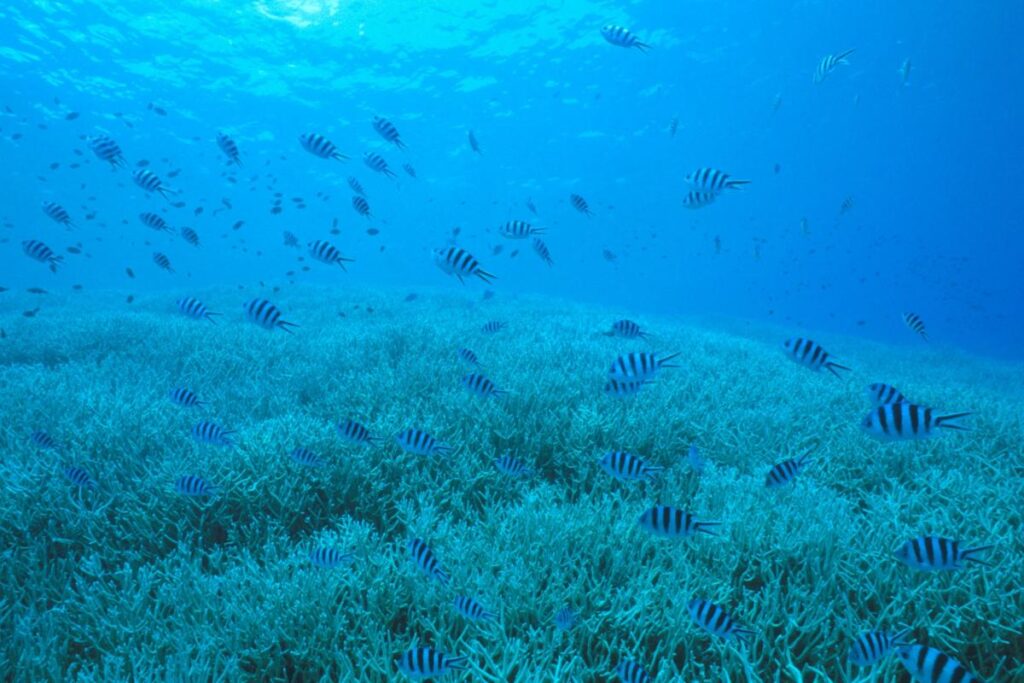Japan, though renowned for its bustling cities and vibrant urban life, is also home to some of the world’s most captivating natural landscapes and diving opportunities. Three of the nation’s UNESCO World Heritage areas, located in the southern parts of the country, exhibit exceptional biodiversity and ecological significance, particularly below the water’s surface. The Ogasawara Islands, Yakushima, and Okinawa not only boast rich histories and serene communities but also teem with life in their pristine ocean environments. Each of these locations provides divers with a unique experience, from striking coral reefs to encounters with diverse marine species, making them ideal for underwater exploration amidst Japan’s scenic beauty.
The Ogasawara Islands, situated about 620 miles south of Tokyo, are a remarkable collection of over 30 islands, most of which remain uninhabited. Tagged as Japan’s “Galapagos,” they earned UNESCO World Heritage status in 2011 due to their unique ecosystems that showcase the evolutionary processes of flora and fauna. The islands’ volcanic origins are manifested in their lush forests and dramatic topography, leading to azure waters brimming with marine life. For divers, the experience is unparalleled, with popular dive sites such as Shikahama, where one can spot sand-tiger sharks, and Yome Island’s Tuna Cave known for turtles and dogtooth tuna. The seasonal migration of humpback whales from February to April adds an extraordinary aspect to diving here, while summer creates ideal conditions for witnessing dolphins and exploring various dive sites.
Yakushima, a UNESCO site since 1993, is famous for its dense forests dominated by ancient cedar trees and abundant rainfall, which contribute to its rich biodiversity. Positioned southwest of mainland Japan, Yakushima not only captivates with its lofty mountains and mesmerizing scenery but also offers enticing diving experiences. The warm Kuroshio Current brings a wealth of marine life to its waters, making it a hidden gem for divers. Here, divers can find soft coral reefs off the northwest coast, including spots at Isso and Nagata that cater to both beginners and seasoned divers. The region is notable for wreck dives like that of a Japanese wartime Zero fighter plane, along with a vibrant underwater ecosystem filled with turtles, hammerheads, and various fish species, allowing for year-round diving, albeit with varying conditions throughout the seasons.
Okinawa serves as another diving paradise, characterized by a blend of modern lifestyles and indigenous culture. The main island, Okinawa Honto, is approximately 900 miles from Tokyo and is celebrated for its natural beauty, with areas like Yanbaru recently recognized as UNESCO World Heritage sites. The waters around Okinawa offer year-round diving, thanks to the warm Kuroshio Current encouraging a rich diversity of marine life. Advanced divers can challenge themselves at Cape Hedo, known for its steep drop-offs and vigorous currents that attract an array of fish, including barracudas and sea turtles. The USS Emmons shipwreck, resting at a depth of 131 feet along Okinawa’s coast, presents an exciting dive for experienced explorers, coupled with stunning oceanic vistas and vibrant coral ecosystems throughout the region.
Each of these UNESCO World Heritage locations provides unique diving experiences, showcasing an ocean teeming with life. The Ogasawara Islands captivate with their isolation and preserved ecosystems, while Yakushima enchants with its lush landscapes and diverse underwater life. Meanwhile, Okinawa impresses with a mix of maritime culture, historical significance, and dynamic dive sites featuring everything from coral reefs to shipwrecks. Whether encountering large pelagic species or exploring intricate coral structures, divers are ensured memorable adventures across these stunning sites.
To access these diving havens, travelers face varying degrees of logistical intricacies. Reaching the Ogasawara Islands requires a lengthy ferry journey from Tokyo, taking approximately 24 hours, while Yakushima can be accessed via a shorter ferry or flight options from Kagoshima. Okinawa’s Yanbaru area is conveniently reachable from Naha Airport, with car rentals recommended to explore the island fully. Moreover, accommodation options range from eco-resorts in Ogasawara to traditional guesthouses in Yakushima and luxury treehouses in Okinawa, providing options that cater to diverse preferences and budgets.
In conclusion, exploring these three UNESCO World Heritage sites in southern Japan offers not just an opportunity to dive into some of the world’s most abundant marine habitats, but also the chance to immerse oneself in the region’s unique cultural and historical heritage. From the untouched environments of the Ogasawara Islands to Yakushima’s ancient forests and Okinawa’s fusion of tradition and modernity, underwater adventurers are likely to find a facet of Japan that many travelers overlook, combining natural beauty, wildlife encounters, and unforgettable diving experiences in one splendid journey.

